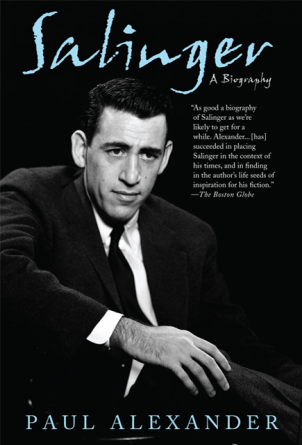By Alexei C. Summers (The Cascade) – Email
Print Edition: November 9, 2011
 There are few literary icons as enigmatic and mysterious as the reclusive JD Salinger, author of highly-lauded coming-of-age novel The Catcher in the Rye. There is very little known about Salinger because he rarely granted interviews, and when he did he did not allow video or audio recording; thus, he went into hiding for much of his life. There are no primary sources when it comes to an investigation into the life of JD Salinger, for JD Salinger did not want to talk, and most of the people who knew him still to this day respect his wishes for privacy. Paul Alexander seeks to tear down these high walls of solitude that the hermit author constructed during his time on this earth in order to gain a better understanding of who the man was and what happened to him in his book entitled Salinger: A Biography.
There are few literary icons as enigmatic and mysterious as the reclusive JD Salinger, author of highly-lauded coming-of-age novel The Catcher in the Rye. There is very little known about Salinger because he rarely granted interviews, and when he did he did not allow video or audio recording; thus, he went into hiding for much of his life. There are no primary sources when it comes to an investigation into the life of JD Salinger, for JD Salinger did not want to talk, and most of the people who knew him still to this day respect his wishes for privacy. Paul Alexander seeks to tear down these high walls of solitude that the hermit author constructed during his time on this earth in order to gain a better understanding of who the man was and what happened to him in his book entitled Salinger: A Biography.
Salinger, as a biography, explores the author’s motivations and relationships, as well as the events that shaped him into the lone wolf literary figure that he became. Nothing is very clear about Mr. Salinger, but one thing about this biography is exceedingly clear – JD Salinger did not want it to be written. To write the biography, Alexander relied on notes from an earlier attempt at a Salinger biography written by British author Ian Hamilton. Salinger found out about this work-in-progress and sought out legal action against it, achieving this by blocking its publication on the grounds that the manuscript contained his personal letters quoted word-for-word. Years later, Alexander picked up those same notes and continued where Hamilton had left off, this time excluding the letters, and being very careful not to do anything that might give Salinger the ability to block publication again. In the end, there was nothing JD Salinger could do, and the book was published.
It has been almost a year since the author passed on in his home in Cornish, New Hampshire, and while many fans were hoping for a new story to be published upon his death, so far there has been no such luck. The last story that Salinger published was in 1965. The story was entitled Hapworth 16, 1924; it was published in The New Yorker.
But why the silence? Alexander proposes several times throughout his book the quite fantastic claim that perhaps the whole “I don’t want to talk to you, get off my lawn,” hermit-thing was just a ruse created by Salinger to gain publicity. If that is indeed true, it worked, because Salinger became well-known for his strange, elusive behaviour.
The book is full of fun Salinger anecdotes, stories from his old war buddies with whom he stormed the beaches of Normandy, and the chasing off of the Nazi scourge in the forests of France. As well, there is a glimpse into Salinger’s childhood and college days where he faced much anti-Semitism in early 20th century New York City, and then eventually it also takes a look at his later years where he seemingly lived in the middle of nowhere for the rest of his days. There are frightening interludes, and images that might disturb some Salinger fans. Salinger is not exactly portrayed as the kindest man in the biography – in fact, he’s revealed as being quite the monster to his wives. Residents of Cornish interviewed in the book recall him as having been kind and just a regular person who wanted his privacy. The book reports that Cornish, by the 1980s, had become something of a tourist attraction for many literary types because they would come to get a glimpse of this man who did not want to be seen. Locals would send them on wild goose-chases when asked for directions to his house. Of course, all they had to really do was read Alexander’s book, because quite invasively, the author gives vague, and yet still obvious, directions to the author’s home.
This examination into the author’s life is quite revealing, and shows us many things we did not know about JD Salinger. Be prepared to be a little disillusioned, for it does not always paint a pretty portrait of the author; in many sections of the book, his very sanity is even called into question. The book is informative, does not pretend to answer any questions, and, in fact, it probably makes more than it resolves, but for the most avid Salinger fans, it is a must read.




